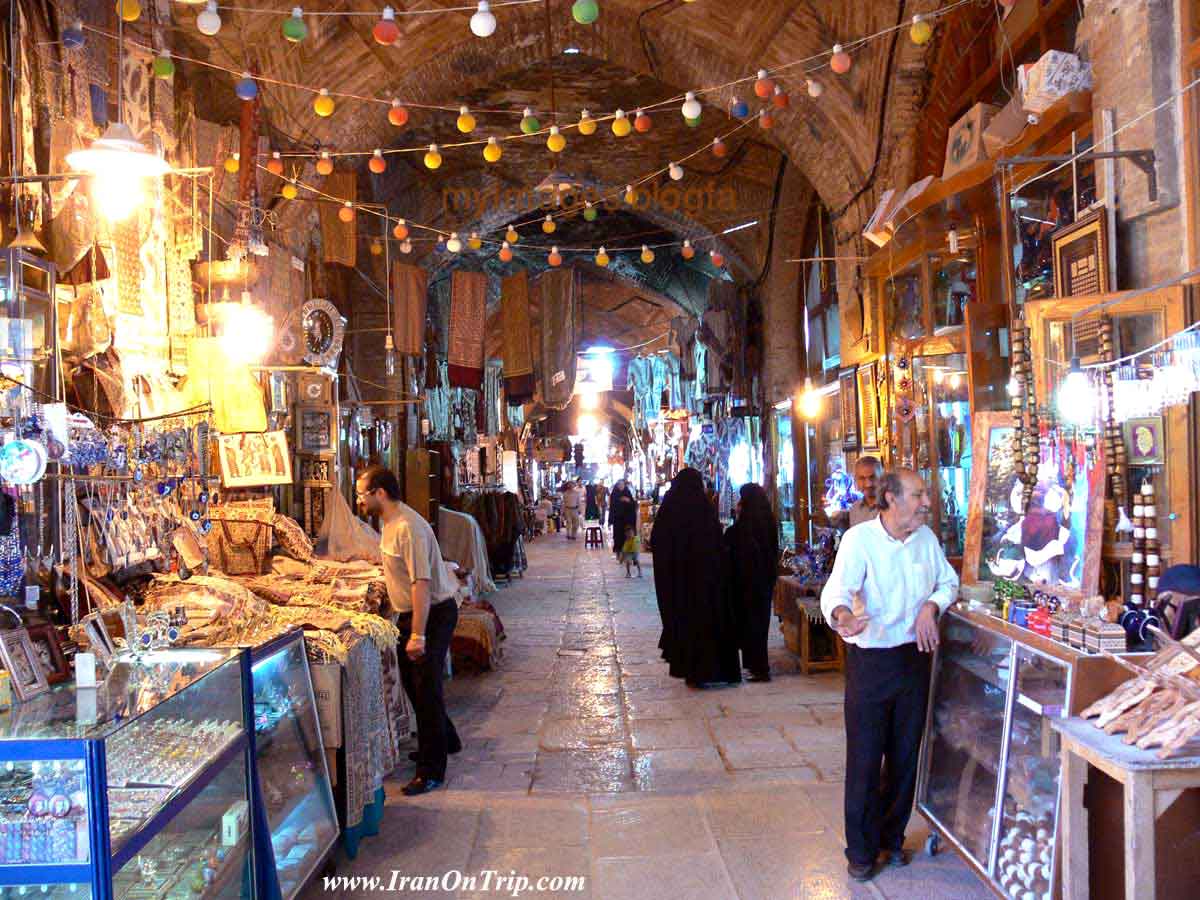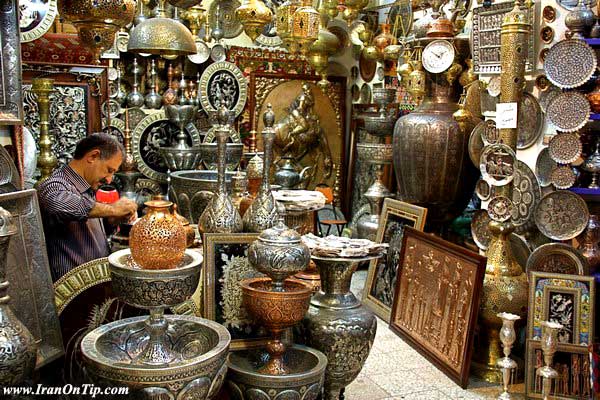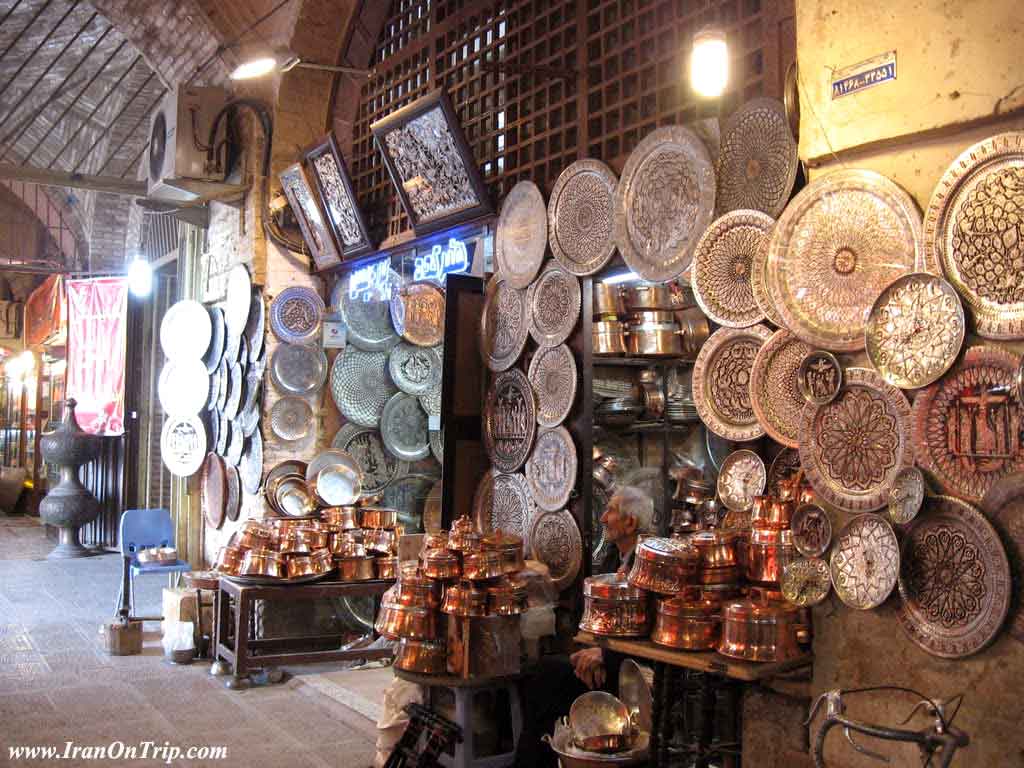Bazaar of Isfahan

After selecting Isfahan as the seat of Shah Abbas, a new bazaar was designed between the old bazaar and the square. Shah Abbas redeveloped the city extensively and had a number of new bazaars built: the buildings surrounding the Naghsh-e-Jahan square (originally including a large number of coffee houses), both the Hasan-abad and mosque bazaars to the south east and the large bazaar to the north, where the old bazaar was located.
As a result it contains a representative selection of Islamic secular architecture over the last 500 years. It has about 5 km (3miles) of shopping streets (raste), some with brick arches, some with poplar beams, over a hundred caravanserais and sarais, innumerable covered halls (timce) and connecting wings (dehliz).As mentioned, Naghsh-e-Jahan is surrounded by a layer of shops. Behind these shops there are several parts of the bazaar, like caravanserais and peripheral markets for different businesses. Based on non-documented stories, after the construction of the new Friday mosque, called the Shah mosque and located in the square, Shah Abbas attempted to encourage people to participate in Friday prayer in the Shah mosque, instead of the old Friday mosque (Masjed-e Jame). But most people rejected participation in Friday prayers in the Shah mosque, and for a while there two Friday prayers conducted in Isfahan; one in the Shah mosque and another one in the old Friday mosque. People had not accepted the new square as a city center. Then Shah Abbas decided to donate all the shops around the new square to people under the regulations of waqf. In this case nobody was obliged to pay to buy these shops. After that gradually Naghsh-e-Jahan square replaced the old square as the main city center for gatherings, shopping, and participating in Friday prayer.The old square soon deteriorated into a wood and vegetable market, but the high class retail businesses established themselves where they could expect a good turnover from the courtiers, soldiers and visitors from the nearby Chaharbagh street. The area to the east of the main axis, the qaiseriya and its extension, the jitsazha (fabric painters' bazaar), became the most sought-after site.

The Bazaar was the backbone of the city. The Bazaar was also used as the main street in Isfahan and a place for meeting people, seeing and being seen. This kind of bazaar acted as a real heart of the city. By counting the number of madrasa, mosques and hammams in the Bazaar we can understand to what extent the Bazaar acted as the center of Isfahan. Also there are some other small buildings in the bazaar such as water stores, warehouses and stables.The most important difference between the old and the new Bazaar is the organic growth of the old section in a linear form and the radial growth of the new bazaar. The old Bazaar was developed based on meeting the needs of the society and providing the best accessibility for people in the neighborhood residential quarters, called mahalleh.Also it should be noted that the reason for the development of the old market into the north was that even before Safavid some residential quarters like Khaju were located in the south and this bazaar was developed as the main street for the residents of Isfahan. Another reason was the Zayandeh River, which was located at the south of new square. As we were told, Safavid Bazaar was carefully designed, in contrast to the old Bazaar.After Qajar dynasty in the 18th century, some bazaars were added to every residential quarter. These bazaars, called neighborhood bazaars, acted as quarter centers. They consisted of a set of facilities, such as shops, hammam (Bathhouses), maktab (schools) as well as commercial activities. They served as large public centers for gathering all of the people to participate in social activities such as religious festivals and making decisions aboutthe quarter (mahalleh) in light of central government.In some historical texts there is written that many of the social and religious ceremonies were conducted in the main Bazaar and neighborhood bazaars. It was common to invite a group of merchants to lunch in the Bazaar. In this case a sarai or timce acted as a ceremonial place.Unfortunately, in recent years the economic role of the main Bazaar has been decreased. The main reason for this phenomena is the import of goods from western countries and establishing many economic complexes on the outside of the Bazaar, which have provided possibilities in all parts of the city to provide their needs without any need to come into the Bazaar.Some parts of the Bazaar were ruined in the Pahlavi dynasty when modern streets were designed in Isfahan. Similarly some parts of the Bazaar, especially the lateral raste for carpet sellers, which had connected the Bazaar to Chaharbagh Street, have been ruined in recent years.[38] But fortunately, traditional life and the increasing number of tourists cause the bazaar still to survive and continue its life as the heart of Isfahan.
The Bazaar of Isfahan, like other bazaars in Islamic cities, can be divided into three parts:
1. Raste and dehliz, which are the main and peripheral streets and corridors inside the bazaar.
2. Caravansarais, which are the economic complexes with stores and places for (residing) housing merchants.
3. Qaisarya, timce and sarai, which are economic complexes without any residential possibilities.

The bazaar of Isfahan is one of the best-preserved examples of the kind of large, enclosed, and covered bazaar complex that was typical of most cities in the Muslim world prior to the 20th century. The oldest areas of the present-day bazaar date from the early 17th century; its first stone was laid in 1603. Prior to this date the bazaar of Isfahan was concentrated around the Meydān-e kohna, the old town center. In 1590 Shah ʿAbbās had decided to move his capital to Isfahan, and although he initially renovated the old bazaar, he later decided to construct a new city center of palaces, mansions for his dignitaries, mosques, and other functional buildings around a new meydān, the so-called Meydān-e Naqš-e Jahān. In 1602 work on the new meydān began . First, a one-story façade of arches and porticoes was built, which faced the new square. Through a number of large and small gates people could access the square and the covered bazaar complex behind them. Secondly, an upper-story (bālā-ḵāna) was built, with commercial offices and artisan shops that were open to the square. Initially, some 200 shops surrounded the square; each was two stories and about five meters high. The lower-story each contained two shops, and the upper-storey four smaller shops, two facing the square and two at the back, which had a small balcony with a protective brick railing. Most of the original floors were made of marble, while the floors added later were colored tiles and stone . It took, of course, a few decades before the bazaar finally acquired its critical mass. Because the new bazaar at first had to meet the needs of the royal palace complex, the mansions of the Safavid elite as well as of their visitors, the bazaar is often referred to as the royal bazaar. The bazaar at the old square continued mainly to serve the needs of the general population, but it gradually fell into disuse and its entire function was absorbed by the new bazaar .
The bazaar still forms the commercial heart of Isfahan, because of its location and continued central commercial function. Its importance is further enhanced by the fact that it is surrounded by a number of public shopping thoroughfares which, although formally not part of the original bazaar complex, nevertheless are now an integral and dynamic part it. Like all bazaars it has no residential function at all, for it is only dedicated to a large variety of commercial and socio-religious functions. As to the commercial use of the bazaar there are a great variety of trades, crafts and service providers that work in its many shops and sarāys. There are both itinerant and stationary retail activities, private and public services (which include mosques, bathhouses, coffeehouses, public kitchens and simple inns)
.....
.....
.....

.jpg)



























